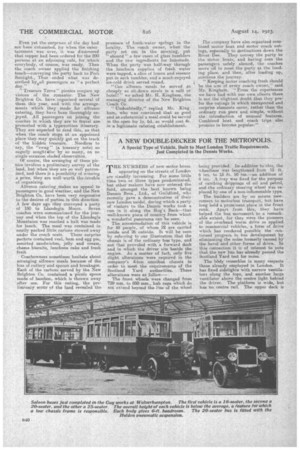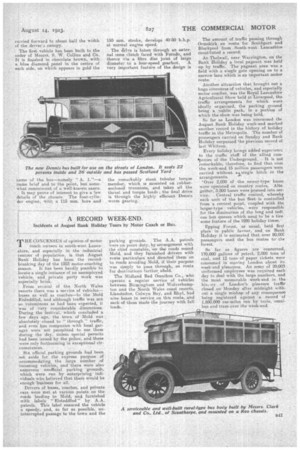A NEW DOUBLE-DECKER FOR THE METROPOLIS.
Page 24

Page 25

If you've noticed an error in this article please click here to report it so we can fix it.
A Special Type of Vehicle, Built to Meet London Traffic Requirements, Just Completed in the Dennis Works.
THE', NUMBERS of new motor buses appearing on the streets of London are steadily increasing. For some little time two or three types predominated, but other makers have now entered the field, amongst the best known. being Dennis Bros., Ltd:-, of Guildford, who recently gave a demonstration of their new London model, during which a party of vieitors to the Dennis works took a run in it along the, Hog's Back—that well-known piece of country from which a wonderful panorama can be seen.
The accommodation of this vehicle is for 48 people, of whom 22 are carried ineide and 26 outside,. It, will be seen by referring to our illustration that the chassis is of the ordinary buts type, and not that provided with a forward dash and in which the driver sits beside the engine. As a matter of fact, only five Slight alterations were required in the company's 4-ton omnibus chassis in order to meet the requirements of the Scotland Yard authorities, These alterations were at follow— The front wheels were changed from 720 mm. -to 850 mm., hub caps which do not, extend beyond the line of the wheel belie,. provided. In -addition tothis, the whee'fbase was lengthened from15 ft. 6 ins. to 1.5 It. 10 ins—an addition of 4 ins. A tray was fixed for the purpose of catching drippings of oil and petrol, and the ordinary steering wheel was replaced by one of a non-inflammable type.
The builders are by no means newcomers to moterb-us transport; but have long held a prominent place in the front rank. Apart from this, they have helped the bus movement to a remarkable extent, for they were the pioneers
the overhead worm drive as applied to commercial vehicles, a form of drive which has rendered possible the continued progress in bus development by eliminating the noise formerly caused by the bevel and other forms of drive. In this connection it is of interest to note that the new bus has already passed the Scotland Yard test for noise.
The body resembles in many respects those already employed in London. It has fixed sidelights with narrow ventila,tars along the tops, and another large ventilator above the centre light behind the driver. The platform is wide, but has no centre rail. The upper deck is carried forward to about half the width of the ,driver's canopy.
The first vehicle has been built to the order of Messrs. S. W. Collins and Co. It is finished in chocolate brown, with a blue diamond panel in the centre of each side, on which appears in gold the
name of the bus—namely "A. 1."—a name brief and to the point., but somewhat reminiscent of a well-known sauce.
• It may prove of interest to give a few details of the chassis; The four-cylinder engine, with a 115 nun, bore and 150 mm. stroke, develops 4050 b.h.p. at normal engine speed.
The drive is taken through an external cone clutch faced with Penedo, and thence via a fibre disc joint of large diameter to a four-speed gearbox.. A very important feature of the design is the remarkably stout tubular torque member, which is mounted on /libberenclosed trunnions, and takes all the thrust and torque, loads ; the final drive is through the highly efficient Dennis worm gearing.




























